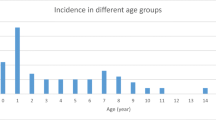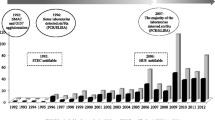Abstract
Background
Shigatoxin (Stx)-producing Escherichia coli (STEC) are the most common causes of hemolytic uremic syndrome (STEC-HUS). The aim of our study is to compare the risk of developing STEC-HUS in relation to the type of Stx genes (Stx1, Stx2, or both).
Methods
This is a prospective, observational, multicenter study involving 63 pediatric units in Northern Italy (ItalKid-HUS Network). STEC-infected children were identified within a screening program for bloody diarrhea during a 10-year period (2010–2019). Stx genes were detected by reverse dot blot or real-time PCR. After the identification of STEC infection, children were followed until diarrhea complete recovery for the possible development of STEC-HUS.
Results
Of the 214 Stx-positive patients, 34 (15.9%) developed STEC-HUS. The risk of HUS in STEC-infected children with Stx1 (n: 62; 29.0%) and Stx2 (n: 97; 45.3%) was respectively 0% and 23.7%, while in patients carrying both Stx1 and Stx2 (n: 55; 25.7%), the risk was 12.7% (p: 0.001).
Conclusions
Our data confirm that Stx1 is a very rare cause of STEC-HUS and demonstrate that the risk of STEC-HUS halves in the case of Stx1+2-producing Escherichia coli infection compared with infections where Stx2 is present alone. This observation is helpful in assessing the risk of individual STEC-infected patients for the development of HUS and suggests that Stx1, in the presence of Stx2, might exert a protective role possibly by receptor competition.
Similar content being viewed by others
Abbreviations
- HUS:
-
Hemolytic uremic syndrome
- STEC:
-
Shigatoxin (Stx)-producing Escherichia coli
- KRT:
-
Kidney replacement therapy
References
Ardissino G, Salardi S, Colombo E, Testa S, Borsa-Ghiringhelli N, Paglialonga F, Paracchini V, Tel F, Possenti I, Belingheri M, Civitillo CF, Sardini S, Ceruti R, Baldioli C, Tommasi P, Parola L, Russo F, Tedeschi S (2016) Epidemiology of haemolytic uremic syndrome in children. Data from the North Italian HUS network. Eur J Pediatr 175(4):465–473
Boyce TG, Swerdlow DL, Griffin PM (1995) Escherichia coli O157:H7 and the hemolytic-uremic syndrome. N Engl J Med 333(6):364
Walsh PR, Johnson S (2018) Treatment and management of children with haemolytic uremic syndrome. Arch Dis Child 103(3):285–291
Tarr PI, Gordon CA, Chandler WL (2005) Shiga-toxin producing Escherichia coli and heamolytic uremic syndrome. Lancet 365(9464):1073–1086
Ake JA, Jelacic S, Ciol MA, et al (2005) Relative nephroprotection during Escherichia coli O157:H7 infections: association with intravenous volume expansion. Pediatrics 115(6)
Ardissino G, Tel F, Possenti I, Testa S, Consonni D, Paglialonga F, Salardi S, Borsa-Ghiringhelli N, Salice P, Tedeschi S, Castorina P, Colombo RM, Arghittu M, Daprai L, Monzani A, Tozzoli R, Brigotti M, Torresani E (2016) Early volume expansion and outcomes of hemolytic uremic syndrome. Pediatrics 137. https://doi.org/10.1542/peds.2015-2153
Gould LH, Bopp C, Strockbine N, Atkinson R, Baselski V, Body B, Carey R, Crandall C, Hurd S, Kaplan R, Neill M, Shea S, Somsel P, Tobin-D’Angelo M, Griffin PM, Gerner-Smidt P; Centers for Disease Control and Prevention (CDC) (2009) Recommendations for diagnosis of shiga toxin producing Escherichia coli infections by clinical laboratories. MMWR Recomm 58(RR-12):1–14
Petro CD, Trojnar E, Sinclair J, Liu ZM, Smith M, O’Brien AD, Melton-Celsa A (2019) Shiga toxin type 1a (Stx1a) reduces the toxicity of the more potent Stx2a in vivo and in vitro. Infect Immun 87:e00787-18
Friedrich AW, Bielaszewska M, Zhang WL, Pulz M, Kuczius T, Ammon A, Karch H (2002) Escherichia coli harboring Shiga toxin 2 gene variants: frequency and association with clinical symptoms. J Infect Dis 185(1):74–84
EU-RL VTEC_Method_02_Rev 0 (2013) Identification and characterization of Verocytotoxin-producing Escherichia coli (VTEC) by Real Time PCR amplification of the main virulence genes and the genes associated with the serogroups mainly associated with severe human infections; http://old.iss.it/vtec/index.php?lang=2&tipo=3
Karmali MA, Mascarenhas M, Shen S, Ziebell K, Johnson S, Reid-Smith R, Isaac-Renton J, Clark C, Rahn K, Kaper JB (2003) Association of genomic O island 122 of Escherichia coli EDL 933 with verocytotoxin-producing Escherichia coli seropathotypes that are linked to epidemic and/or serious disease. J Clin Microbiol 41(11):4930–4940
Bielaszewska M, Mellmann A, Bletz S, Zhang W, Köck R, Kossow A, Prager R, Fruth A, Orth-Höller D, Marejková M (2013) Enterohemorrhagic Escherichia coli O26:H11/H−: A New Virulent Clone Emerges in Europe. Clin Infect Dis 56(10):1373–1381
Brigotti M (2012) The interactions of human neutrophils with shiga toxins and related plant toxins: danger or safety? Toxins 4:157–190
Karpman D, Stahl AL, Arvidsson I (2017) Extracellular vesicles in renal disease. Nat Rev Nephrol 13:545–562
Ståhl AL, Arvidsson I, Johansson KE, Chromek M, Rebetz J, Loos S, Kristoffersson AC, Békássy ZD, Mörgelin M, Karpman D (2015) A novel mechanism of bacterial toxin transfer within host blood cell-derived microvesicles. PLoS Pathog 11:e1004619
Brigotti M, He X, Carnicelli D, Arfilli V, Porcellini E, Galassi E, Tazzari PL, Ricci F, Patfield SA, Testa S, Paglialonga F, Picicco D, Caprioli A, Scavia G, Morabito S, Ardissino G (2020) Particulate Shiga toxin 2 in blood is associated to the development of hemolytic uremic syndrome in children. Thromb Haemost 120(1):107–120
Acknowledgments
The following members of the ItalKid-HUS Network, to whom we are particularly thankful, gave an essential contribution to the present study: P. Accorsi (Pieve di Coriano), P. Adamoli (Gravedona), N. Altamura (Sesto San Giovanni), S. Andreoni (Novara), M. Andreotti (Desio), M. Arghittu (Melegnano), C. Baldioli (Cittiglio), B. Balduzzi (Esine), A. Bonazza (Brescia), A. Bonomini (Melzo), A. Bosco (Varese), G. Bossi (Pavia), E. Cama (Desenzano del Garda), P. Carlucci (Milano), M. Casciana (Mantova), D. Casnaghi (Rho), D. Cattarelli (Desenzano del Garda), R. Ceruti (Mantova), R. Colombo (Milano), S. Consolo (Milano), A. Corti (Desenzano del Garda), A. Dodaro (Milano), M. Frediani (Milano), M.R. Gallina (Aosta), C. Giacomazzi (Aosta), V. Goj (Milano), S. Grossi (Brescia), A. Lepre (Crema), S. Maiandi (Lodi), M.C. Mancuso (Milano), C. Masia (Milano), L. Martelli (Bergamo), M.L. Melzi (Monza), E. Milanesi (Cremona), A. Monzani (Novara), A. Negri (Varese), B.S. Orena (Milano), B. Osnaghi (Magenta), F. Pagani (Brescia), F. Paglialonga (Milano), L. Parola (Magenta), P. Pedroni (Manerbio), A. Pellegatta (Busto Arsizio), M. Perrone (Milano), D. Picicco (Milano), G. Pieri (Alessandria), S. Poli (Esine), A. Reciputo (Cinisello Balsamo), B. Roman (Vimercate), A. Rosco (Garbagnate), F. Salvini (Milano), S. Sardini (Asola), C. Sciuto (Lecco), M. Silvestri (Verbania), F. Tel (Milano), S. Testa (Milano), P. Tommasi (Milano), A. Vigo (Ivrea), C. Zambetti (Lodi).
We are also very thankful to “PROGETTO ALICE–ASSOCIAZIONE PER LA LOTTA ALLA SEU” for their support and continuous commitment to our research.
Author information
Authors and Affiliations
Contributions
All authors contributed to the study conception and design. Material preparation and data collection were performed by Gianluigi Ardissino and Valentina Capone. Laboratory testing was performed by Chiara Vignati and Laura Daprai.
Data analysis was performed by Gianluigi Ardissino, Dario Consonni, Maurizio Brigotti, and Mario Vittorio Luini. The first draft of the manuscript was written by Ilaria Possenti and Gianluigi Ardissino and all authors commented on the various versions of the manuscript. All authors read and approved the final manuscript.
Corresponding author
Ethics declarations
Conflict of interest
The authors declare that they have no conflicts of interest.
Additional information
Publisher’s note
Springer Nature remains neutral with regard to jurisdictional claims in published maps and institutional affiliations.
Rights and permissions
About this article
Cite this article
Ardissino, G., Possenti, I., Vignati, C. et al. Is Shigatoxin 1 protective for the development of Shigatoxin 2-related hemolytic uremic syndrome in children? Data from the ItalKid-HUS Network. Pediatr Nephrol 35, 1997–2001 (2020). https://doi.org/10.1007/s00467-020-04697-y
Received:
Revised:
Accepted:
Published:
Issue Date:
DOI: https://doi.org/10.1007/s00467-020-04697-y




